The female sex toys market has seen remarkable growth over recent years, fueled by shifting social attitudes, increased accessibility, and a surge in demand for quality, tech-enabled products. This blog delves into the current trends, projected growth, and key factors driving this market forward.
The global sex toys market value is expected to reach $80.7 B at 16.09% CAGR in 2030, with female sex toys dominating the market share. Brands like Womanizer and Lora DiCarlo are innovating with products such as AI-driven vibrators and app-controlled devices, catering to a generation that prioritizes sexual wellness as an essential component of self-care.
Market Size and Growth Overview
Let us understand the market behavior of female sex toys.
Current Market Valuation
Selling sex toys online is a profitable business today, and selling female sex toys is the peak of it. Female sex toys dominate the global sex toys market, holding a significantly larger share compared to male-focused products. This trend highlights the growing demand for diverse and innovative products in the female segment, driven by increased societal acceptance and the prioritization of sexual wellness. As illustrated in the graph below, the global market size for female sex toys has seen notable growth over recent years.
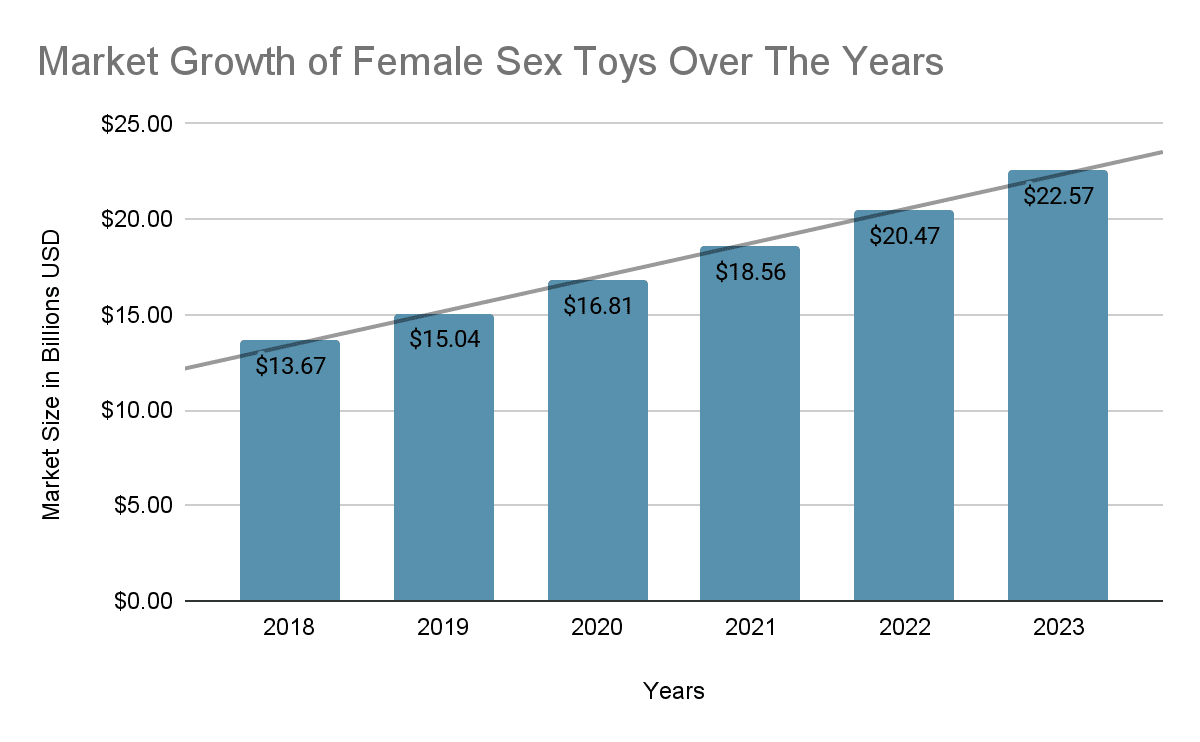
In 2023, the market was valued at $22.57 billion and is growing at 10.23% CAGR. This upward trajectory reflects the expanding consumer base and the ongoing investment in technology and product variety to enhance user experience.
Forecasted Growth and Key Projections
The female sex toys market is expected to experience steady growth through 2032, with a projected compound annual growth rate (CAGR) of around 10.26% and reach a market size of $54.37 B.
This expansion is driven by a combination of factors, including increased awareness of sexual wellness, changing cultural perceptions, and the rise of online retailing, which has made these products more accessible globally. By 2032, the global market value is anticipated to nearly double as more consumers integrate sexual wellness into their overall self-care routines.
Regional growth in the female sex toys market is expected to vary considerably. North America is projected to hold a significant share, driven by high consumer awareness, a diverse range of established brands, and increasing adoption of tech-enabled products. The region’s sex toys market is forecasted to grow at a CAGR of 4.5% during the projected period.
Europe is set to follow closely, with its growth fueled by evolving cultural attitudes and a well-established market infrastructure. Key countries such as the UK, Italy, and France are anticipated to play pivotal roles, contributing to an estimated CAGR of 5.1% throughout the forecast period. These regions illustrate the dynamic shifts in consumer behavior and the expanding opportunities within the market.
The Asia-Pacific region is poised for the fastest growth in the female sex toys market, driven by growing openness toward sexual health conversations, increasing disposable incomes, and the rapid expansion of e-commerce platforms that enhance product accessibility. This region is expected to account for 46% of the market’s growth in the coming years, underscoring its pivotal role in shaping the industry’s future.
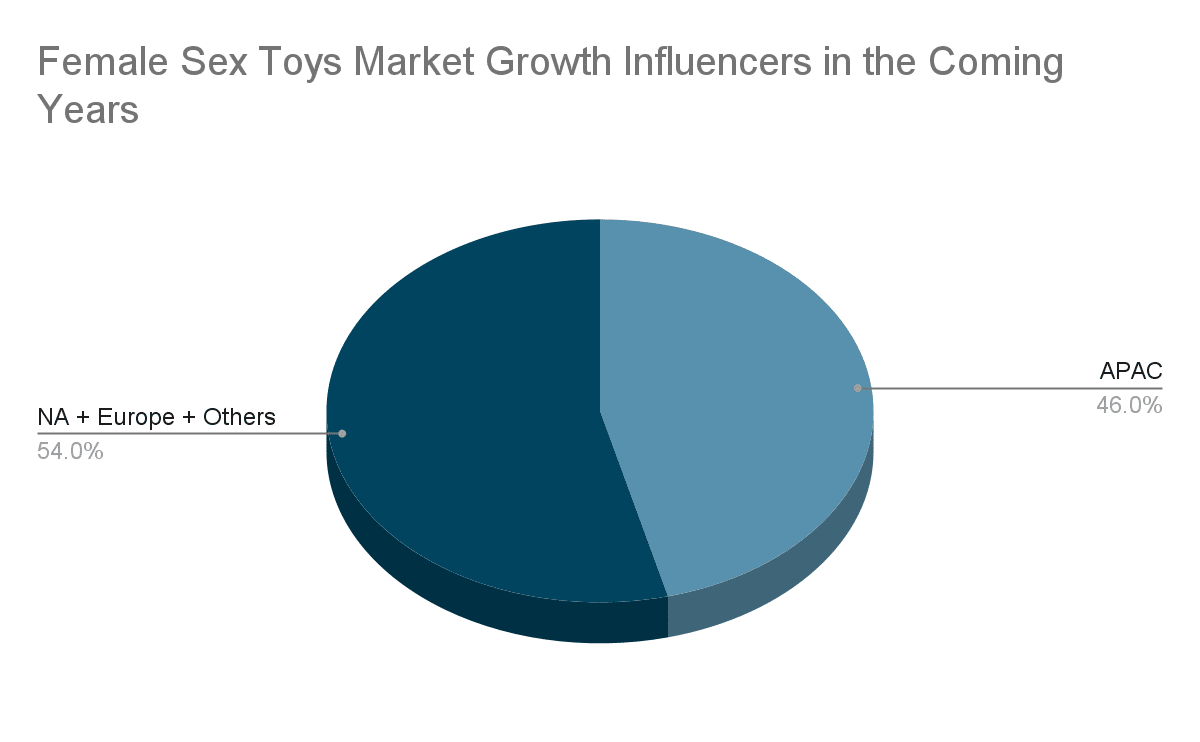
Factors Contributing to Growth
The growth of the female sex toys market is driven by several key factors. Increased awareness of sexual health and wellness, supported by educational campaigns and the integration of sexual wellness into self-care routines, has normalized the use of products like vibrators and stimulators.
The growing visibility and acceptance of the LGBTQ+ community have also played a pivotal role in market expansion. Products designed with inclusivity in mind, such as strap-ons and gender-affirming toys, have seen increased demand. Nearly 28% of Millennials and Gen Z identify as LGBTQ+, underscoring the community’s growing and influential role as a key consumer base for female sex toys.
The rise of e-commerce and direct-to-consumer (DTC) channels has revolutionized the market. Platforms like Amazon, eBay, and niche-focused retailers have made purchasing sex toys more accessible and private, erasing much of the stigma previously associated with buying these products.
Pricing strategies for sex toys are also one of the critical factors that contribute to the growth of female sex toys. Manufacturers identifying the market and pricing their products reasonably well within the grasp of buyers have played a role in its improved market size.
Key Market Trends in the Female Sex Toys Industry
Now that we have understood the market size, let us look into what the market demands in terms of female sex toys.
Rise of Sexual Wellness and Health Products
The market for sexual wellness and health-focused products has experienced rapid growth, driven by a global shift toward prioritizing self-care and holistic well-being. As societal attitudes around sexual health evolve, sex toys are increasingly seen not just as tools for pleasure but as essential products for maintaining physical and mental health.
Research on U.S. adults reports high importance of sexual health for life quality, with 62% of men and 43% of women stating it as critical, which has played a role in increasing demand for female sex toys. Consumers are gravitating toward sex toys designed with wellness in mind, such as those that promote relaxation, alleviate stress, or enhance intimacy.
Personalization and Smart Technology Integration
The incorporation of AI and app-connected devices is transforming the female sex toys market, addressing the increasing demand for personalized and technology-driven solutions. These innovations allow users to tailor their experiences and interact with their devices in new and unique ways.
A survey reveals that 65% of consumers prefer products with app connectivity, enabling control across multiple devices—a trend that also applies to female sex toys.
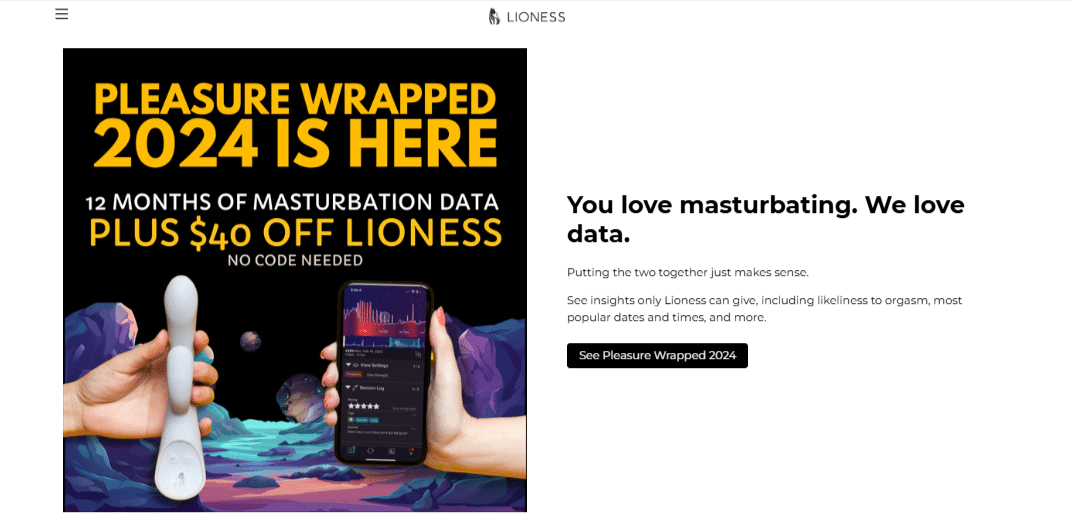
App integration facilitates remote control, discreet use, and long-distance connectivity, which have become key selling points just like the Lioness Smart Vibrator: This device tracks biometric data, such as pelvic floor movements, to provide insights into user pleasure patterns, helping users enhance their experiences through data-driven suggestions. Consumers increasingly seek products that cater to their unique needs and preferences. Smart devices in this market often feature:
- Adjustable intensity and pattern settings.
- Ability to create, save, and share personalized vibration patterns.
- Voice-activated or motion-controlled operations for hands-free use.
Sustainability and Eco-Friendly Products
Sustainability is becoming a key focus in the female sex toys market, with eco-conscious consumers driving demand for environmentally friendly options. Brands are responding by using body-safe, biodegradable, and recyclable materials to create sustainable products.
Companies like Love Not War produce vibrators with recyclable aluminum and interchangeable heads to reduce waste. Many brands use minimal, recyclable packaging to align with eco-conscious values.

Inclusive and Body-Positive Branding
The female sex toys market is undergoing a transformative shift toward inclusivity and body positivity, breaking traditional norms and addressing the needs of a broader audience. This trend is driven by evolving consumer expectations and the desire for more diverse representation in products and advertising.
Modern brands are designing products that cater to various body types, anatomies, and gender identities. For example, Wild Flower created the Enby, a gender-neutral sex toy designed for versatile use by people of all identities.

Brands are moving away from stereotypical depictions and are now showcasing diverse models and authentic narratives in their campaigns. Today’s products emphasize diverse bodies, skin tones, and age groups in their marketing materials.
Consumer Demographics and Preferences
Now that we have understood the trends within the female sex toy industry, let us study who drives them.
Key Demographic Insights
Millennials (ages 27–42) and Gen Z (ages 18–26) are the primary drivers of growth in the sex toys market. Millennials and Gen Z dominate the market, with 65% of sex toy consumers falling within this age group. Millennials prioritize self-care and premium, tech-enabled products, while Gen Z, known for their openness about sexual health, are particularly drawn to app-connected and AI-driven innovations.
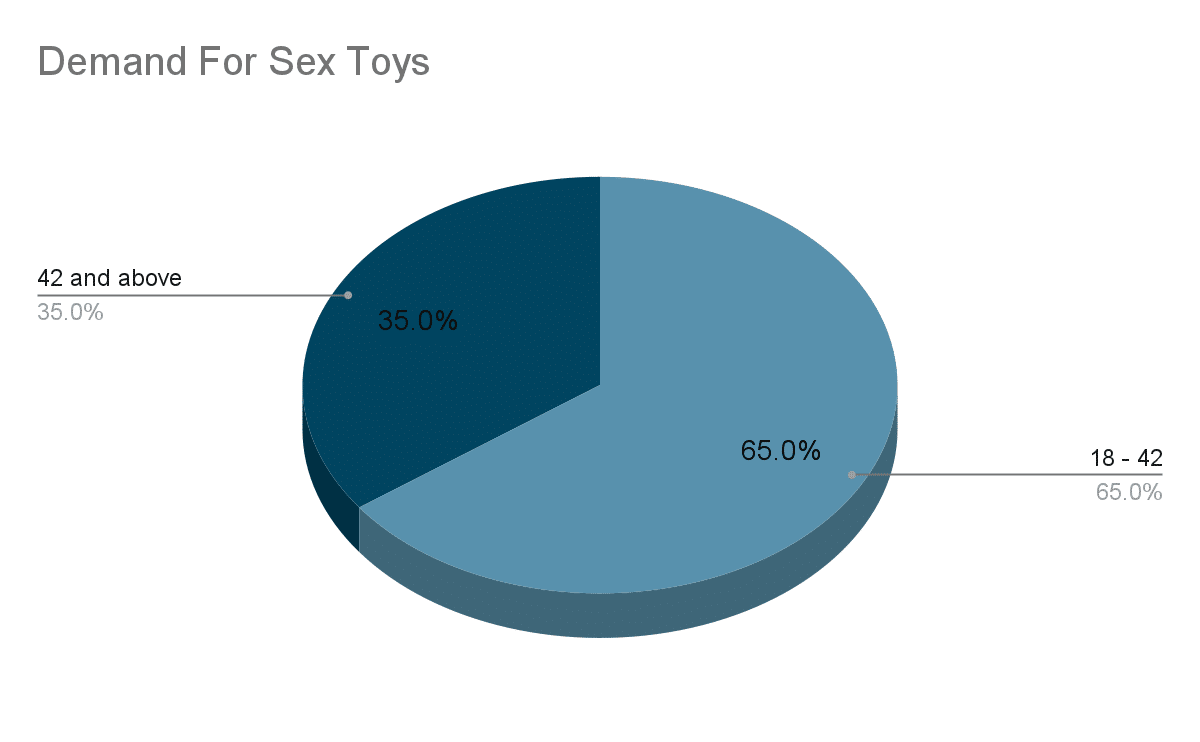
Changing Preferences and Purchase Behavior
As the female sex toys market evolves, consumer preferences and purchase behaviors are shifting toward more discreet, aesthetic, and premium products.
Consumers are increasingly looking for products that offer both functionality and style. Discreet designs that blend seamlessly into home décor or can be easily concealed have become highly desirable.
Consumers are also willing to invest more in high-quality, premium products with enhanced features, longer-lasting durability, and superior materials. This shift toward luxury has increased demand for products made with body-safe materials, advanced technology, and innovative features.
LELO, a brand known for its luxury sex toys, consistently sees strong sales growth due to its high-end designs and advanced technology. Their LELO Sona 2 vibrator, priced at over $109, features sonic waves and body-safe silicone, combining performance with luxury.

Type of Sex Toys
Vibrators, anal toys, sex dolls, strap-ons, and harnesses are among the trending sex toys in today’s market. Of these, vibrators lead the way, holding a dominant 54.53% market share.
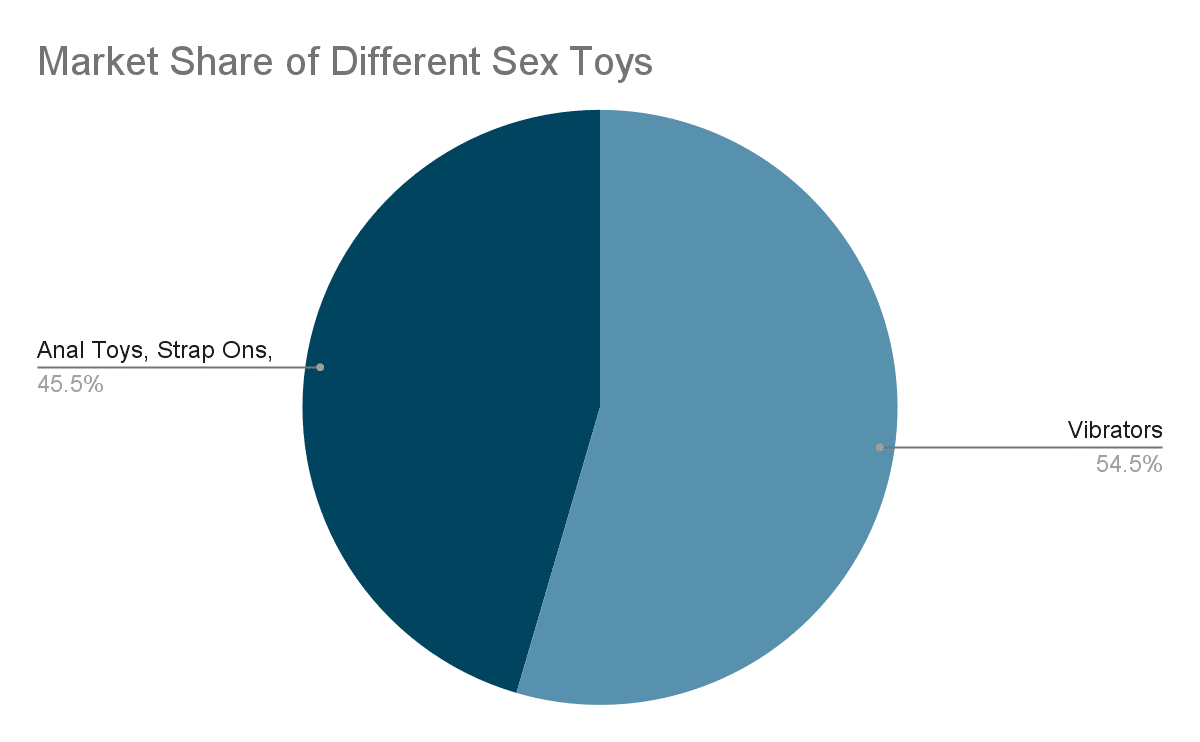
This strong preference for vibrators is driven by their versatility, with options for both clitoral and internal stimulation, making them a top choice for many consumers. As the market continues to evolve, the demand for these products reflects a growing interest in diverse sexual experiences and a shift toward more personalized, pleasure-enhancing devices.
How COVID-19 Impacted Consumer Behavior
The COVID-19 pandemic had a profound impact on consumer behavior, especially in the female sex toys market. Lockdowns and social distancing measures reshaped how people interacted with their sexuality, driving significant changes in purchasing habits and attitudes toward personal wellness.
According to a report, online sales of sex toys surged by 30% during the peak of the pandemic as more people sought out intimate products for self-care and stress relief.
Key Players in the Female Sex Toys Market
After understanding the market type and changing demographics, it is now time to understand who are the key players in the female sex toys market.
Leading Brands and Manufacturers
The female sex toys market is led by several prominent brands that have established themselves as innovators in both product design and technology. These companies are setting the trends and meeting the growing demand for high-quality, personalized, and tech-enabled products.
Adam & Eve, LELO, Lovehoney, and We-Vibe are prominent players in the sex toys market, all of which had a strong performance in 2023, as evidenced by their reported annual revenues shown in the graph below.

Emerging Startups and Boutique Brands
Emerging startups and boutique brands are reshaping the sex toys market by focusing on sustainability, inclusivity, and innovative designs. Brands like Unbound promote body positivity and sexual empowerment, while Wild Flower offers gender-neutral, accessible products.
Maude combines luxury with eco-friendly materials, and Bellesa Boutique normalizes women’s sexual pleasure with premium yet affordable options. Femme Funn creates fun, powerful, and affordable vibrators, prioritizing accessibility. These brands cater to consumers who are seeking more personalized, socially responsible products.
Competitive Landscape Analysis
The female sex toys market is highly competitive, with a mix of established brands and emerging players shaping the industry’s growth. A few key players, Adam & Eve, LELO, and Lovehoney, predominantly hold market share, while strategic moves such as mergers, acquisitions, and partnerships are helping these companies solidify their positions and expand their reach.
Major players in the sex toys industry are actively pursuing strategic mergers, acquisitions, and partnerships to maintain and grow their market share. For instance, Lovehoney collaborated with the Fifty Shades of Grey franchise to tap into new markets and enhance its brand influence through co-branded product lines and cross-promotions. Additionally, Lovehoney merged with WOW Tech, a company renowned for its innovative brands like We-Vibe and Womanizer.
This merger has enabled the combined entity to strengthen its market presence, diversify its product portfolio, and leverage technological advancements to serve consumer demands better globally. These strategic moves highlight the industry’s focus on innovation, market expansion, and brand synergies to stay competitive in a growing market.
Distribution Channels and Marketing Strategies
After understanding who sells the most female sex toys, let us take a look into how they sell sex toys online vs. brick-and-mortar sex toy stores.
E-commerce and Direct-to-Consumer Models
The distribution channels and marketing strategies in the female sex toys market have evolved significantly, with a strong shift toward e-commerce and direct-to-consumer (DTC) models.
E-commerce has revolutionized the sex toys market by offering a discreet and convenient shopping experience, allowing consumers to explore options without stigma. In the U.S., 44% of consumers purchase sex toys online, compared to 39% in the U.K., reflecting a strong preference for digital platforms in both regions.
Direct-to-consumer (DTC) models have strengthened brands’ connections with customers, offering privacy through non-descriptive packaging and accessibility with 24/7 online availability.
Key platforms include Amazon, known for its wide range and fast shipping; brand websites like LELO and Womanizer, which offer personalized recommendations and educational content; and specialty sites like Lovehoney, which provide curated selections and expert advice for a tailored shopping experience. These channels have made sexual wellness products more accessible and user-friendly.
In 2023, sex toys sales through the above said model accounted for 63.8% of the sex toys market revenue, significantly outpacing brick-and-mortar retail.
Brick-and-Mortar Stores and Boutique Retail
While e-commerce dominates the sex toys market, brick-and-mortar stores and boutique retail outlets remain significant, particularly for customers seeking a tactile, in-person shopping experience. Specialty stores focusing on sexual wellness, such as Babeland and The Pleasure Chest, provide curated selections and expert guidance in a welcoming, judgment-free environment.
Modern retail spaces have evolved with redesigned in-store displays prioritizing privacy, inclusivity, and education. Open layouts, discreet packaging, and informative signage create a comfortable customer atmosphere.
Influencer Marketing and Social Media Trends
Influencer marketing has become a powerful tool in promoting sex toys, with creators on platforms like Reddit, X (formerly Twitter), Instagram and TikTok normalizing discussions around sexual wellness. Influencers provide authentic reviews and recommendations, helping brands reach diverse audiences and break taboos. Brands like Lovesense are using the influencers regularly to promote their store and products.
However, navigating censorship on social media remains a challenge. Platforms often restrict or flag content related to sexual health, pushing brands to use creative strategies like subtle messaging, educational content, and collaborations with sex-positive influencers. These efforts ensure visibility while adhering to platform guidelines, driving awareness and destigmatizing the conversation around sexual wellness products.
Regional Analysis of the Female Sex Toys Market
Let us analyze the prominent markets for female sex toys.
North America
The North American sex toys market was valued at USD 13,944.15 million in 2022 and is projected to reach USD 23,694.65 million by 2028, with the female sex toys segment expected to grow at a robust CAGR of 13.64% between 2023 and 2028.
The U.S. leads as both the largest buyer and seller of female sex toys, with 82% of women owning at least one sex toy, while Canada ranks as the fifth-largest sex toy seller globally. In 2023, North America accounted for 33.24% of global revenue, driven by critical manufacturers like Doc Johnson, which produces over 75% of its products domestically.
The region is poised to maintain a dominant 48.5% market share during the forecast period of 2021 to 2030, supported by factors such as widespread acceptance, minimal social stigma, and easy access to products, reflecting strong interest.
Europe
The European sex toys market is projected to experience the fastest growth during the forecast period, driven by contributions from crucial nations such as Germany, Italy, France, the United Kingdom, Denmark, and Belgium. Germany leads the region, holding approximately 27.9% of the market share and emerging as the most significant contributor within Europe.
The female segment dominates the market, accounting for 60% of the share and generating a revenue of USD 5.1 billion. The European market is expanding steadily, with a CAGR of 7.6% anticipated from 2021 to 2030, fueled by increasing openness towards sexual wellness and body positivity across the region.
Asia-Pacific
The Asia-Pacific sex toys market is projected to reach USD 11.177 billion by 2030, growing at a steady CAGR of 6.15% from 2022 to 2030. The female segment leads the market, contributing over 60% of total sales. This growth is driven by increasing acceptance of sexual wellness products, rising disposable incomes, and a shift in cultural attitudes across countries like China, Japan, and India.
The expansion of e-commerce platforms and discreet marketing strategies also play a crucial role in making these products more accessible to consumers in the region. Despite challenges related to cultural sensitivities and regulatory barriers, the Asia-Pacific market shows significant potential for further growth, especially as younger, tech-savvy demographics embrace sexual wellness products.
Challenges Facing the Female Sex Toys Market
As there is demand, there are also challenges that affect the female sex toys market.
Regulatory and Legal Challenges
The regulatory landscape for female sex toys varies significantly across countries, creating hurdles for manufacturers and retailers. While some regions, such as North America and Western Europe, have relatively relaxed regulations, others impose strict bans on production, sale, and marketing. Following legal guidelines for selling sex toys is, therefore, crucial for being in the business.
Online sales add another layer of complexity, as advertising restrictions and platform-specific censorship policies limit visibility and accessibility. For example, social media platforms like Instagram and Facebook often flag or block ads related to sexual wellness, forcing brands to find alternative ways to engage their audience.
Social and Cultural Barriers
Societal stigma and cultural taboos around sex toys remain significant barriers in many regions, particularly in Asia, the Middle East, and Africa. In these areas, discussing sexual wellness is often discouraged, limiting consumer awareness and acceptance.
However, companies are actively working to break down these barriers through educational campaigns, inclusive advertising, and collaborations with influencers who promote body positivity and sexual empowerment. These efforts aim to normalize the market and foster more open conversations about sexual health.
Sustainability Challenges
As consumer demand for eco-friendly products grows, the sex toys industry faces the challenge of balancing environmental sustainability with production costs. Sustainable materials like body-safe silicone, biodegradable plastics, and recyclable packaging are increasingly sought after, but they are more expensive to produce and integrate into existing supply chains.
Leading brands, such as LELO and Maude, have started addressing these concerns by incorporating eco-friendly practices, but widespread adoption remains a work in progress.
Innovations and Technological Advances in Female Sex Toys
Innovation serves as the primary driving force in the female sex toys market, shaping its growth and evolution through groundbreaking ideas and advancements.
AI and Smart Technology in Sex Toys
The integration of AI and innovative technology is transforming the female sex toys market, offering users highly personalized and interactive experiences. Intelligent connectivity, such as app-controlled devices, allows users to customize settings, access pre-set modes, and even sync their toys with music or partner controls from remote locations.
For example, brands like OhMiBod have introduced app-compatible vibrators that enable users to adjust intensity and patterns in real-time. OhMiBod’s BlueMotion connects to an app that syncs vibrations to music or voice commands, offering an immersive and customizable experience. AI technology further enhances these devices, with some products learning user preferences over time to deliver tailored experiences.

Advancements in Materials and Safety Standards
The industry has also seen significant advancements in materials and safety standards, ensuring products are safe, durable, and comfortable to use. Manufacturers now prioritize body-safe materials like medical-grade silicone and hypoallergenic plastics to reduce the risk of irritation and allergic reactions.
Regulatory frameworks, such as the CE marking in Europe and FDA regulations in the U.S., are crucial in maintaining product safety. For instance, LELO, a leading brand, uses ultra-smooth silicone and adheres to stringent safety standards, positioning itself as a trusted name in the market.
Future Opportunities and Market Forecast in the Female Sex Toys Market
Projected Market Trends and Innovations
The female sex toys market is poised for continued growth, driven by advancements in personalization, health-focused features, and intelligent technologies. Consumers are increasingly seeking products that cater to individual needs, such as app-controlled devices with customizable settings and AI-driven features that enhance user experience.
The market is also expanding into the wellness sector, with products designed to address sexual health concerns like pelvic floor strength and stress relief, appealing to a broader audience. Emerging economies, including those in Asia-Pacific and Latin America, offer untapped opportunities as cultural attitudes toward sexual wellness gradually evolve.
Areas of Expansion and Potential Partnerships
The market presents significant opportunities for partnerships and collaborations. For instance, aligning with wellness brands could help manufacturers position sex toys as integral to self-care routines, making them more appealing to mainstream consumers. Collaborations with healthcare providers and therapists also hold promise, particularly in developing products that address medical concerns such as sexual dysfunction or postnatal recovery.
Additionally, partnerships with technology firms could lead to the development of more innovative, data-driven products. As consumer interest in sexual wellness continues to rise, brands that embrace these opportunities will be well-positioned to lead the next phase of growth in the female sex toys market.
FAQs About Female Sex Toys Market
1. What is the projected growth rate for the female sex toys market?
The female sex toys market is projected to grow steadily at a compound annual growth rate (CAGR) of approximately 10.26%, reaching an estimated market value of $54.37 billion by 2032.
2. Which demographics are driving demand for female sex toys?
Millennials (ages 27 to 42) and Gen Z (ages 18 to 26) are the key demographics propelling the growth of the female sex toys market. Geographically, North America, Asia-Pacific, and Europe are the leading regions driving this demand.
3. How has technology impacted the female sex toys industry?
App-controlled female sex toys are increasingly popular among modern consumers, who prefer devices that can be operated via apps and enhanced with AI to adapt to their behavior and preferences.
Conclusion
The female sex toys market is undergoing a transformative period, driven by innovation, shifting societal attitudes, and increasing consumer demand for personalized, health-focused, and sustainable products. With advancements in AI, smart connectivity, and eco-friendly materials, along with growing acceptance across demographics and regions, the industry is poised for significant growth. As brands continue to address challenges and embrace new opportunities, the future of this market promises to be both dynamic and inclusive, catering to a diverse and evolving audience.
Hi
Start Growing Your Dream Business
with Us!
Charles
Chief Marketing Officer at Adent.io
Charles is the Chief Marketing Officer at Adent.io, where he directs marketing strategies that drive the company’s growth and innovation. Alongside his primary role, Charles also provides expert advice and tailored strategies to Adent.io’s clients, empowering them to thrive in the competitive adult industry.


